Peace River region introduced to the 'Water Balance Model for British Columbia'
Canada Mortgage & Housing Corporation (CMHC) organized and the City of Dawson hosted a workshop on sustainable development that was attended by over 30 people. Participants included a contingent from the City of Dawson Creek plus representatives from the Town of Fort St. John, Village of Chetwynd, Village of Pouce Coupe, Peace River Regional District, Peace River School District and the Ministry of Transportation. For the complete story, please click here.
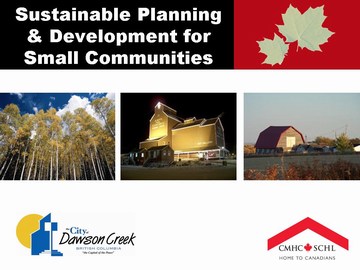
“The audience was diverse and represented a broad cross-section of the region,” observed Lance Jakubec of CMHC, “We had elected officials from the four municipalities. In addition, we had municipal staff and community representatives  such as the Dawson Creek Senior Citizens Association, Dawson Creek Chamber of Commerce, Northeast Environmental Action Team, and Dawson Creek Beautification Committee.” Jakubec was the leader of a 4-person presentation team that also comprised Allan Dobie (an architect with CMHC), Luc Delestrade (Lighthouse Sustainable Building Centre) and Kim Stephens (Program Coordinator, Water Sustainability Action Plan for British Columbia).
such as the Dawson Creek Senior Citizens Association, Dawson Creek Chamber of Commerce, Northeast Environmental Action Team, and Dawson Creek Beautification Committee.” Jakubec was the leader of a 4-person presentation team that also comprised Allan Dobie (an architect with CMHC), Luc Delestrade (Lighthouse Sustainable Building Centre) and Kim Stephens (Program Coordinator, Water Sustainability Action Plan for British Columbia).

The Water Balance Model for British Columbia
 The presentation by Kim Stephens was titled Water – Choosing Sustainability for Life and Livelihoods: An Introduction to the Water Sustainability Action Plan for British Columbia. An engineer-planner, Kim has been invited to speak on the British Columbia experience at forums across North America and in Australia. His innovation related to the rainwater management and watercourse protection strategy for the UniverCity Sustainable Community on Burnaby Mountain is featured in the book Dancing with the Tiger: Learning Sustainability Step by Natural Step.
The presentation by Kim Stephens was titled Water – Choosing Sustainability for Life and Livelihoods: An Introduction to the Water Sustainability Action Plan for British Columbia. An engineer-planner, Kim has been invited to speak on the British Columbia experience at forums across North America and in Australia. His innovation related to the rainwater management and watercourse protection strategy for the UniverCity Sustainable Community on Burnaby Mountain is featured in the book Dancing with the Tiger: Learning Sustainability Step by Natural Step.
LAND DEVELOPMENT AND CHANGES IN HYDROLOGY: The presentation by Stephens was comprehensive in addressing each element of the Water Sustainability Action Plan. The segment on the Water Balance Model for British Columbia was of particular interest to the City of Dawson Creek because they are now experiencing watercourse impacts because of changes in hydrology.  According to Greg Dobrowolski, Manager of Development Services, “Our development standards are quite old, and there was not a lot of development for a long time. Now, with the surge in development resulting from the boom in the oil and gas industry, we are seeing what larger building footprints and more hard surfaces mean in terms of increasing volumes and frequency of rainwater runoff. Our watercourses are being hit hard.”
According to Greg Dobrowolski, Manager of Development Services, “Our development standards are quite old, and there was not a lot of development for a long time. Now, with the surge in development resulting from the boom in the oil and gas industry, we are seeing what larger building footprints and more hard surfaces mean in terms of increasing volumes and frequency of rainwater runoff. Our watercourses are being hit hard.”
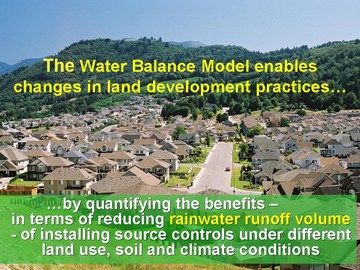
The Water Balance Model is a decision support tool. Kim Stephens reports that: “It was developed as an extension of Stormwater Planning: A Guidebook for British Columbia because people typically need numbers to understand what an infrastructure decision means on the ground.” Published in 2002, the Guidebook was the catalyst that has resulted in British Columbia being recognized internationally as a leader in implementing a natural systems (or design with nature) approach to rainwater management in the urban environment. “The Guidebook is outcome-oriented, and this is what sets it apart from output-oriented approaches that too often lead to paralysis through analysis”, adds Stephens.
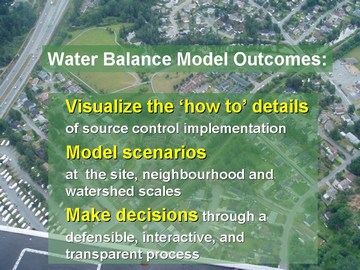
WATER SUSTAINABILITY ACTION PLAN: The Action Plan is being delivered by the BC Water & Waste Association through a partnership 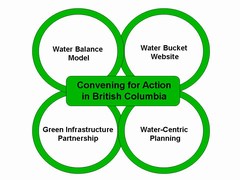 with the Province. For more on this part of the story, please click here. “The Action Plan represents the integration of policy, science and applied science, technical, education and outreach,” reports Kim Stephens, “My contacts in other regions tell me that they are not aware of any other jurisdiction that is implementing anything comparable to what we are doing in British Columbia through Convening for Action pilot programs in three regions. Our focus is very much on-the-ground and we recognize that local government is the key player in changing the way we develop land and use water.”
with the Province. For more on this part of the story, please click here. “The Action Plan represents the integration of policy, science and applied science, technical, education and outreach,” reports Kim Stephens, “My contacts in other regions tell me that they are not aware of any other jurisdiction that is implementing anything comparable to what we are doing in British Columbia through Convening for Action pilot programs in three regions. Our focus is very much on-the-ground and we recognize that local government is the key player in changing the way we develop land and use water.”
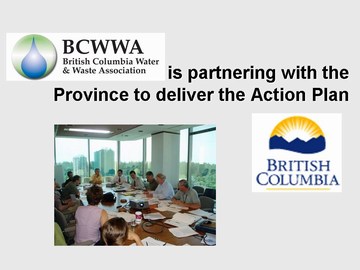
Posted December 2006

